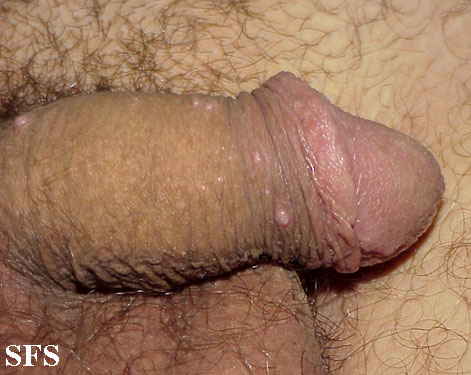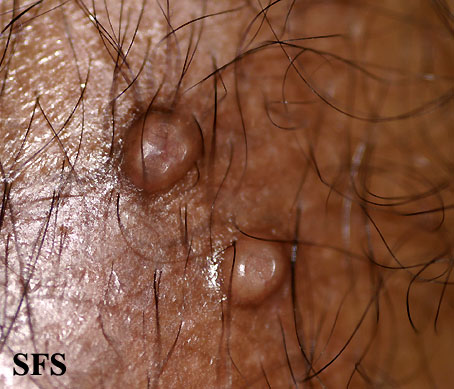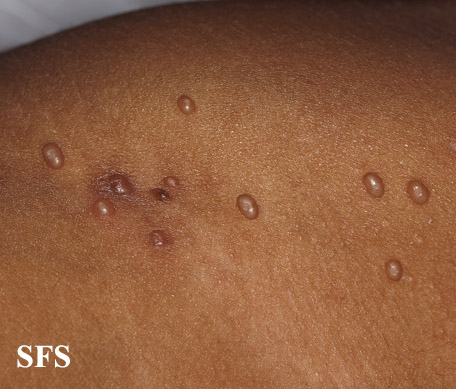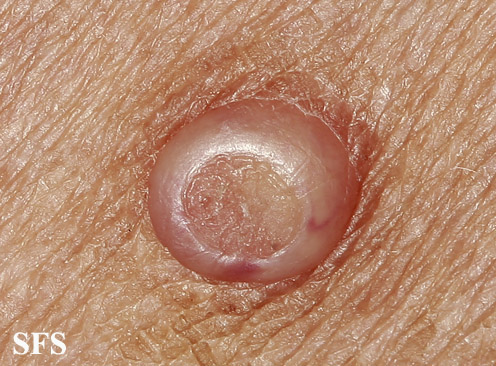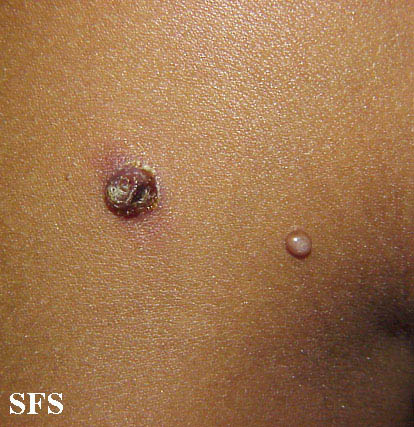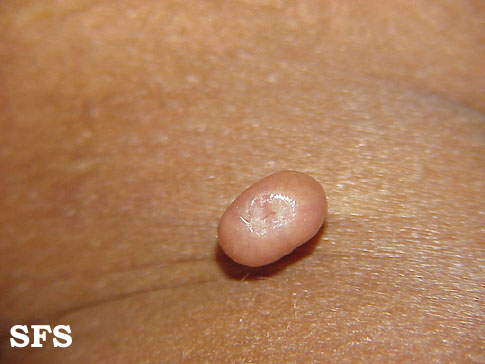Molluscum contagiosum physical examination
|
Molluscum contagiosum Microchapters |
|
Diagnosis |
|---|
|
Treatment |
|
Case Studies |
Editor-In-Chief: C. Michael Gibson, M.S., M.D. [1]; Associate Editor(s)-in-Chief: Mahshid Mir, M.D. [2]
Overview
- The overview section should include the disease name in the first sentence.
- The goal is to summarize the physical examination page in several sentences. This section can be the same as the physical examination segment on the overview page.
- To see an example of an overview section on a physical examination page, click here.
Template
- First Sentences:
- Patients with [disease name] usually appear [general appearance]. Physical examination of patients with [disease name] is usually remarkable for [finding 1], [finding 2], and [finding 3].
- OR
- Common physical examination findings of [disease name] include [finding 1], [finding 2], and [finding 3].
- OR
- The presence of [finding(s)] on physical examination is diagnostic of [disease name].
- OR
- The presence of [finding(s)] on physical examination is highly suggestive of [disease name].
Physical examination
Appearance of the Patient
- This section should give a general description of what a patient with the disease you are describing may look like.
- If patients typically appear normal, you may write: Patients are usually well-appearing.
- You may include a physical description such as obese, thin, cachectic, ill appearing, diaphoretic etc. Mention in which cases these findings are present (e.g. well-appearing in early stages of cancer, cachectic in late stage cancer)
- For an example of the appearance of a patient section in the physical examination page, click here.
Vital Signs
Note: Vital signs traditionally include the temperature, blood pressure, heart rate, respiratory rate. The vital signs may also include oxygen saturation (at room air) and blood glycemia.
- High-grade / low-grade fever
- Hypothermia / hyperthermia may be present
- Tachycardia with regular pulse or (ir)regularly irregular pulse
- Bradycardia with regular pulse or (ir)regularly irregular pulse
- Tachypnea / bradypnea
- Kussmal respirations may be present in _____ (advanced disease state)
- Weak/bounding pulse / pulsus alternans / paradoxical pulse / asymmetric pulse
- High/low blood pressure with normal pulse pressure / wide pulse pressure / narrow pulse pressure
Skin
Note: To describe a rash, always report additional details that include the color (e.g. erythematous), shape (e.g. flat / bullous), dermarcation (e.g. well-circumscribed / diffuse), location (e.g. truncal / on the face / on the extremities), enclosing fluid (e.g. vesicular / filled with pus, clear), and if possible smell (e.g. foul-smelling / odorless)
-
Description (Adapted from Dermatology Atlas)
-
Description (Adapted from Dermatology Atlas)
- Molluscum contagiosum is usually asymptomatic; a minority of patients complain of itching or tenderness.
- itching, ocular pain, burning sensation or other types of pain in the lesions. Ocular pain accompanies eyelid molluscum contagiosum. Curtin et al. found that molluscum can be the cause of unilateral chronic conjunctivitis when the eyelid is involved.[1]
- Children more typically develop multiple site lesions, most commonly on the face, trunk, and extremities, although perineal, scrotal, perianal, and groin lesions may be present as part of a wider distribution.[2]
- Lesions are usually more widespread in children than in adults and, although adults with genital disease rarely develop extra genital lesions, 10-50 percent of infected children have lesions in the genital area.
- chronic localized infection characterized by firm, dome shaped papules on the skin
- Lesions are often 2 to 5 mm in diameter, with a shiny surface and central indentation or umbilication. Occasionally, the growths can be polypoid with a stalk-like base. Pruritus may be present or absent, and lesions sometimes become visibly inflamed.
- Molluscum contagiosum may appear anywhere on the body except the palms and soles. The most common areas of involvement include the trunk, axillae, antecubital and popliteal fossae, and crural folds.
- Lesions on the eyelid can cause conjunctivitis.[3]
- Sexually transmitted molluscum contagiosum typically involves the groin, genitals, proximal thighs, and lower abdomen. In HIV-infected and other immunocompromised patients, lesions can be large (aka giant molluscum) and widespread.
HEENT
- Abnormalities of the head/hair may include ___
- Evidence of trauma
- Icteric sclera
- Nystagmus
- Extra-ocular movements may be abnormal
- Pupils non-reactive to light / non-reactive to accomodation / non-reactive to neither light nor accomodation
- Ophthalmoscopic exam may be abnormal with findings of ___
- Hearing acuity may be reduced
- Weber test may be abnormal (Note: A positive Weber test is considered a normal finding / A negative Weber test is considered an abnormal finding. To avoid confusion, you may write "abnormal Weber test".)
- Rinne test may be positive (Note: A positive Rinne test is considered a normal finding / A negative Rinne test is considered an abnormal finding. To avoid confusion, you may write "abnormal Rinne test".)
- Exudate from the ear canal
- Tenderness upon palpation of the ear pinnae / tragus (anterior to ear canal)
- Inflamed nares / congested nares
- Purulent exudate from the nares
- Facial tenderness
- Erythematous throat with/without tonsillar swelling, exudates, and/or petechiae
Neck
- Jugular venous distension
- Carotid bruits may be auscultated unilaterally/bilaterally using the bell/diaphragm of the otoscope
- Lymphadenopathy (describe location, size, tenderness, mobility, and symmetry)
- Thyromegaly / thyroid nodules
- Hepatojugular reflux
Lungs
- Asymmetric chest expansion / Decreased chest expansion
- Lungs are hypo/hyperresonant
- Fine/coarse crackles upon auscultation of the lung bases/apices unilaterally/bilaterally
- Rhonchi
- Vesicular breath sounds / Distant breath sounds
- Expiratory/inspiratory wheezing with normal / delayed expiratory phase
- Wheezing may be present
- Egophony present/absent
- Bronchophony present/absent
- Normal/reduced tactile fremitus
Heart
- Chest tenderness upon palpation
- PMI within 2 cm of the sternum (PMI) / Displaced point of maximal impulse (PMI) suggestive of ____
- Heave / thrill
- Friction rub
- S1
- S2
- S3
- S4
- Gallops
- A high/low grade early/late systolic murmur / diastolic murmur best heard at the base/apex/(specific valve region) may be heard using the bell/diaphgram of the otoscope
Abdomen
- Abdominal distention
- Abdominal tenderness in the right/left upper/lower abdominal quadrant
- Rebound tenderness (positive Blumberg sign)
- A palpable abdominal mass in the right/left upper/lower abdominal quadrant
- Guarding may be present
- Hepatomegaly / splenomegaly / hepatosplenomegaly
- Additional findings, such as obturator test, psoas test, McBurney point test, Murphy test
Back
- Point tenderness over __ vertebrae (e.g. L3-L4)
- Sacral edema
- Costovertebral angle tenderness bilaterally/unilaterally (may also be referred to as Murphy's punch sign, which is different from Murphy's sign that suggests cholecystitis. To avoid confusion, write "costovertebral angle tenderness")
- Buffalo hump
Genitourinary
- A pelvic/adnexal mass may be palpated
- Inflamed mucosa
- Clear/(color), foul-smelling/odorless penile/vaginal discharge
Write additional pathognomonic findings, such as discharge that resembles cottage cheese for C. albicans vulvovaginitis / fish-odor for T. vaginalis ifnection
Extremities
- Clubbing
- Cyanosis
- Pitting/non-pitting edema of the upper/lower extremities
- Muscle atrophy
- Fasciculations in the upper/lower extremity
Neuromuscular
- Patient is usually oriented to persons, place, and time
- Altered mental status
- Glasgow coma scale is ___ / 15
- Clonus may be present
- Hyperreflexia / hyporeflexia / areflexia
- Positive (abnormal) Babinski / plantar reflex unilaterally/bilaterally
- Muscle rigidity
- Proximal/distal muscle weakness unilaterally/bilaterally
- ____ (finding) suggestive of cranial nerve ___ (roman numerical) deficit (e.g. Dilated pupils suggestive of CN III deficit)
- Unilateral/bilateral upper/lower extremity weakness
- Unilateral/bilateral sensory loss in the upper/lower extremity
- Positive straight leg raise test
- Abnormal gait (describe gait: e.g. ataxic (cerebellar) gait / steppage gait / waddling gait / choeiform gait / Parkinsonian gait / sensory gait)
- Positive/negative Trendelenburg sign
- Unilateral/bilateral tremor (describe tremor, e.g. at rest, pill-rolling)
- Normal finger-to-nose test / Dysmetria
- Absent/present dysdiadochokinesia (palm tapping test)
Gallery
Skin
Head
Eyes
Genitalia
References
- ↑ CURTIN BJ, THEODORE FH (1955). "Ocular molluscum contagiosum". Am. J. Ophthalmol. 39 (3): 302–7. PMID 14350041.
- ↑ Gottlieb SL, Myskowski PL (1994). "Molluscum contagiosum". Int. J. Dermatol. 33 (7): 453–61. PMID 7928025.
- ↑ Schornack MM, Siemsen DW, Bradley EA, Salomao DR, Lee HB (2006). "Ocular manifestations of molluscum contagiosum". Clin Exp Optom. 89 (6): 390–3. doi:10.1111/j.1444-0938.2006.00073.x. PMID 17026608.





